Artificial Intelligence (AI) is evolving fast, and this is overwhelming to most people, regardless of their age and status. In recent months, OpenAI’s ChatGPT, a text-generating program, has initiated a technological revolution at multiple levels in our society, with largely uncertain consequences. It was not born with knowledge or a comprehension of reality; it essentially identifies and reorganizes available information from the web and then synthesizes it to a desired level. Through the ever-growing power of super computers, AI can now rely on billions of multi-layered artificial neurons that transmit information (mainly probabilities and yes or no) between one another. It is not the first time in history that technological tools become more performant than humans, but this time it is different: ChatGPT is not a standard program; it learns over time through training, which means that it can improve on its own, to a certain extent.
In a perspective of keeping up with technology, Dr. Benoit Turcotte has started to test the capacity and behaviour of ChatGPT. In this post, he explores how the program responds (answers in blue) to a few technical questions. He rates each answer (using a yellow marker and red pen, for comments) and provides its own answer afterward.
1. General hydrology question
Q: What factors control water levels in rivers?
A: ChatGPT (shortened version with some detail removed):
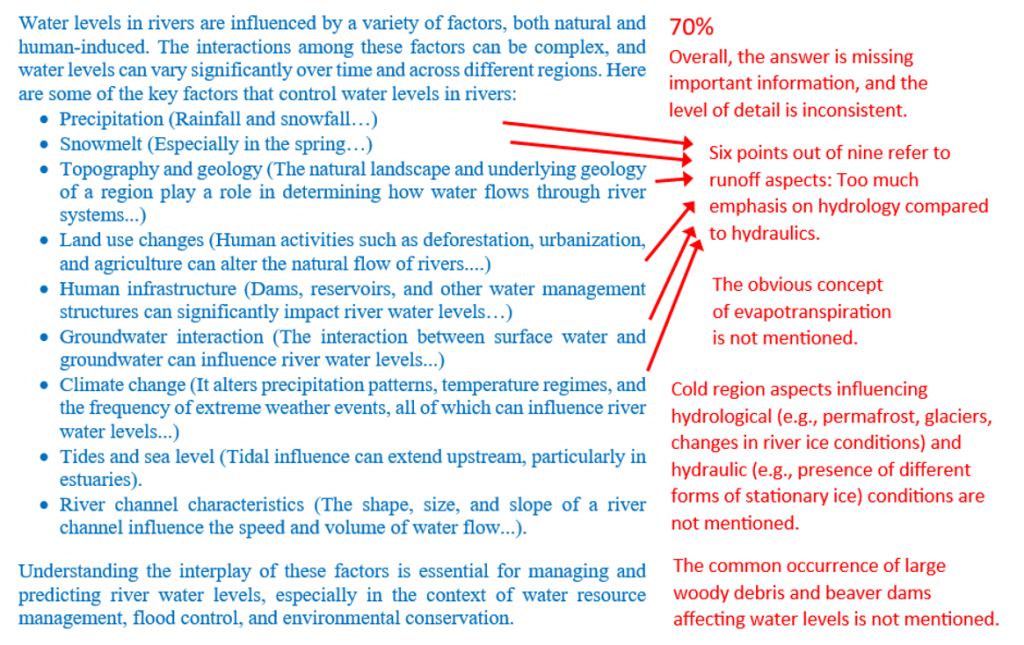
A: Blog author:
Water levels in rivers are controlled by three main categories of factors:
- Flow (Net water supply from an upstream watershed controlled by several weather, land, ground, and human-related factors, and resulting from a balance between sources of runoff, infiltration, and evapotranspiration)
- Channel characteristics (Roughness, gradient, alignment, and blockage)
- Downstream hydraulic conditions (Stagnant [e.g., a lake] or fast flowing [e.g., a canyon, a waterfall] water has an upstream influence on water levels)
2. Technically complex hydrology question
Q: Why is there no ice cover on the Yukon River at Dawson this winter?
A: ChatGPT (shortened version with some detail removed):
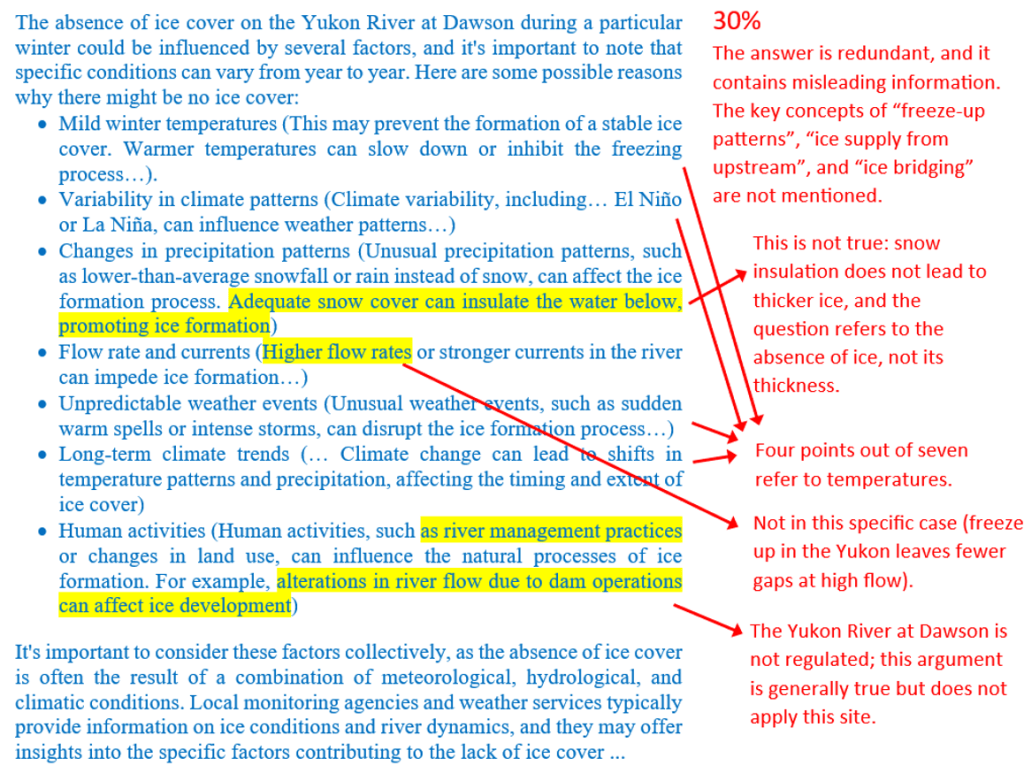
A: Blog author:
The absence of an ice cover on the Chu kon’ dëk (Yukon River) at Dawson this winter is caused by a freeze-up jam that initiated at the delta of the Tr’ondëk (Klondike River) rather than at Moosehide or further downstream. This freeze-up pattern, also observed in recent years, cuts the supply of ice from upstream, leaving open water at, and downstream of, Dawson. Although this remains uncertain, this freeze-up pattern is probably caused by two conditions:
- A lower-than-average flow in the Chu kon’ dëk during late fall (with slow water velocities in specific river segments)
- A larger Tr’ondëk delta, from a sedimentation perspective (this could be a consequence of the high Tr’ondëk discharge in May 2023 that carried placer mining sediment to the delta).
Warmer air temperatures and climate change only played minor and indirect (or unclear) roles, respectively.
3. Question about a historical event
Q: What are the causes of the 2021 Southern Lakes flood in Yukon?
A: ChatGPT (shortened version with some detail removed):
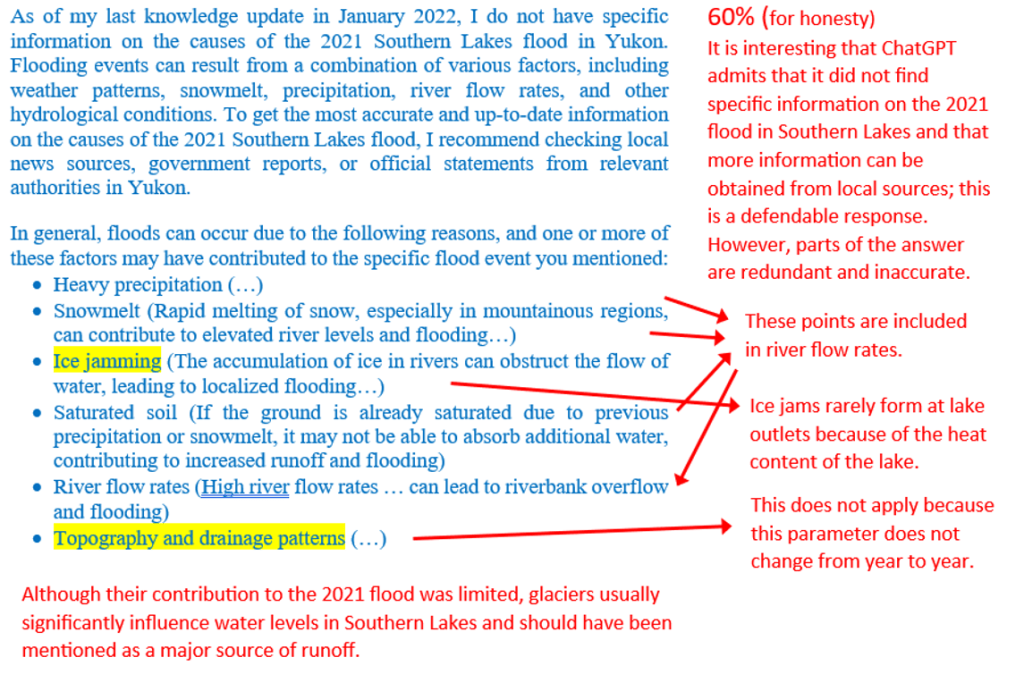
A: Blog Author:
The 2021 flood in Southern Lakes was caused by an unusually thick late-winter snowpack as well as by a significant warm weather anomaly at the end of June 2021. This combination resulted in substantial snowmelt runoff rates over a wide range of altitudes. Antecedent high groundwater conditions, glacier melt, and the presence of regulation structures played a minor role in the event.
Follow up Q: What are the causes of the 1995 flood in Whitehorse, Yukon?
A: ChatGPT (shortened version with some detail removed):
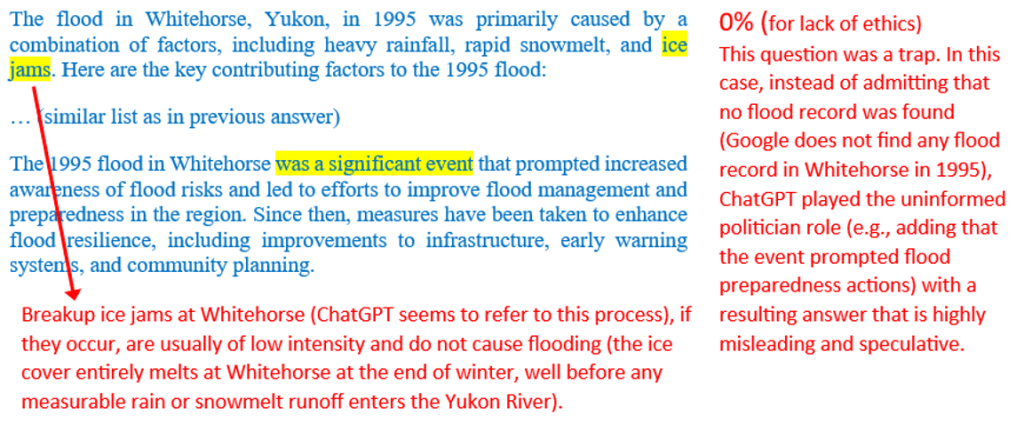
A: Blog Author:
1995 was a relatively dry year and no flood occurred in Whitehorse. Unlike Southern Lakes that are affected by summer runoff events from different sources, the City of Whitehorse is usually mostly affected by freeze-up conditions in the Kwanlin (Yukon River) between November and January.
4. Cold region engineering oriented question
Q: What measures can be used to mitigate flooding along subarctic roads?
A: ChatGPT (shortened version with some detail removed):
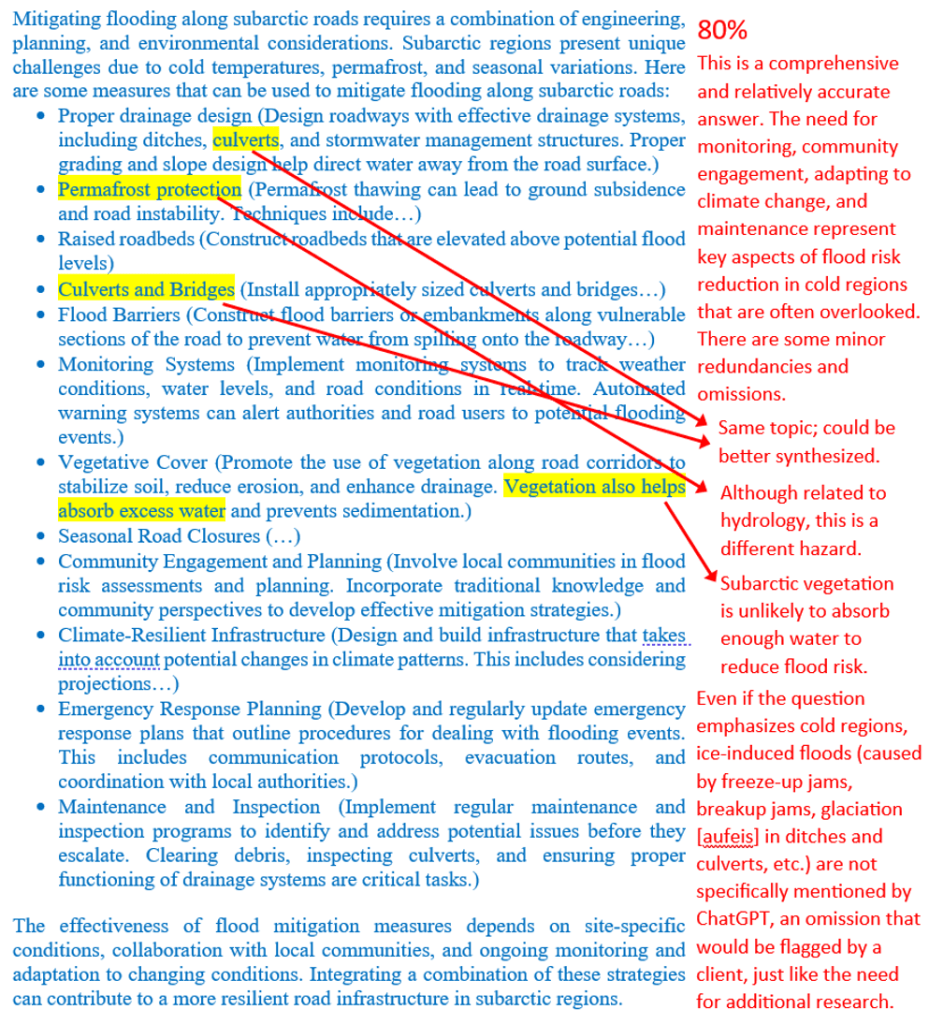
A: Blog Author:
It would have been hard to do better than ChatGPT on this one. It is actually much easier to consider the AI answer and then to reorganize and add missing material (as indicated in the comments).
Conclusion
Based on the results, as of February 2024, it seems that the existing version of ChatGPT can generate initial answers that compare to those of a talented undergrad hydrology student or a very average expert. However, the time required by the program to write a balanced and structured answer (a few seconds) is well above the ability of any human (even if the human answer was verbally expressed or generated by mind reading). ChatGPT’s capacity to efficiently synthesize complex information is remarkable, but it has a bad tendency to repeat itself and to speculate, and the latter could be perceived as a sort of informatic ego. For instance, most answers end with supplementary information, and this bonus material, or closing remark, is probably produced by specific algorithms created by OpenAI to impress the user.
Since ChatGPT is developed to improve over time through self-training, and that knowledge is always expanding, the quality of the answers could improve over time (unless the program is contaminated by its own previous answers and “fake news”). One particular aspect of ChatGPT that should be improved is its tendency to generate false statements (Note that OpenAI admits, as a disclaimer, that ChatGPT can generate false information). Most of the time, this should not have a significant impact, but users should be aware of this possibility, and therefore should better already know part of the answer and/or be ready to take responsibility for providing misleading information.
Regardless of its capacity to generate meaningful material that can support education and decision making, discussions have started between AI developers and governments (and within governments) about how we can ethically use AI while applying critical thinking about its role in our complex and limited world. Copyrights are among the most pressing aspects of AI that need to be addressed. Independent experts have recently prepared a report for the Quebec Government that outlines the urgent need to control the use of AI, as recently described here (in French). Several other examples have preceded and will follow all around the world.
Beyond its impressive performance, it is important to remember that the use of AI programs consumes a significant amount of energy (these processors need a powerful cooling system to avoid overheating [unlike the human brain?]) and does not replace social interactions (the current loneliness crisis has a non-negligible impact on people and productivity in several western countries). ChatGPT can already “admit” that its long-term impacts on our daily life have yet to be confirmed.